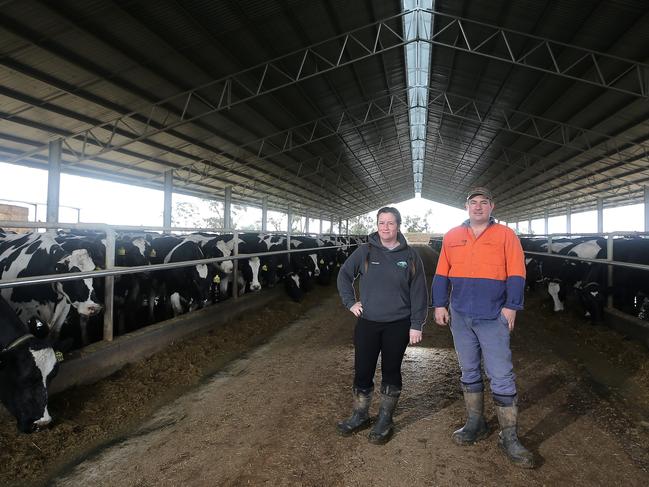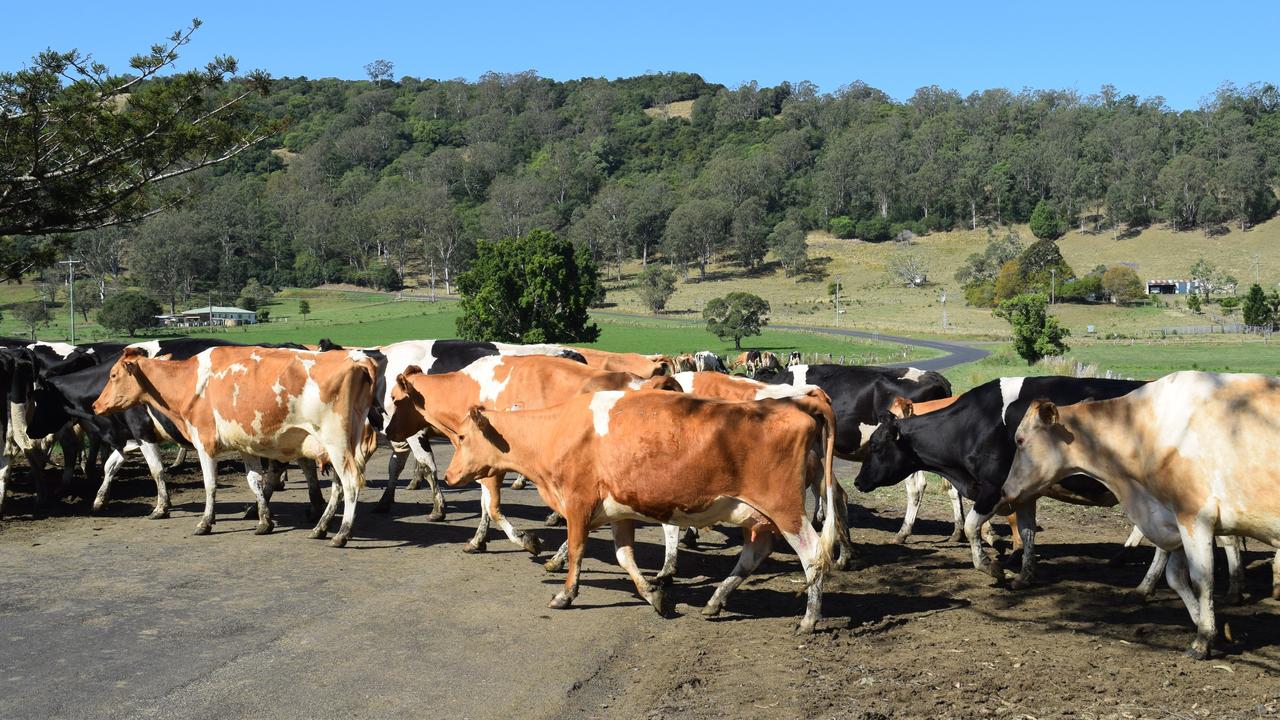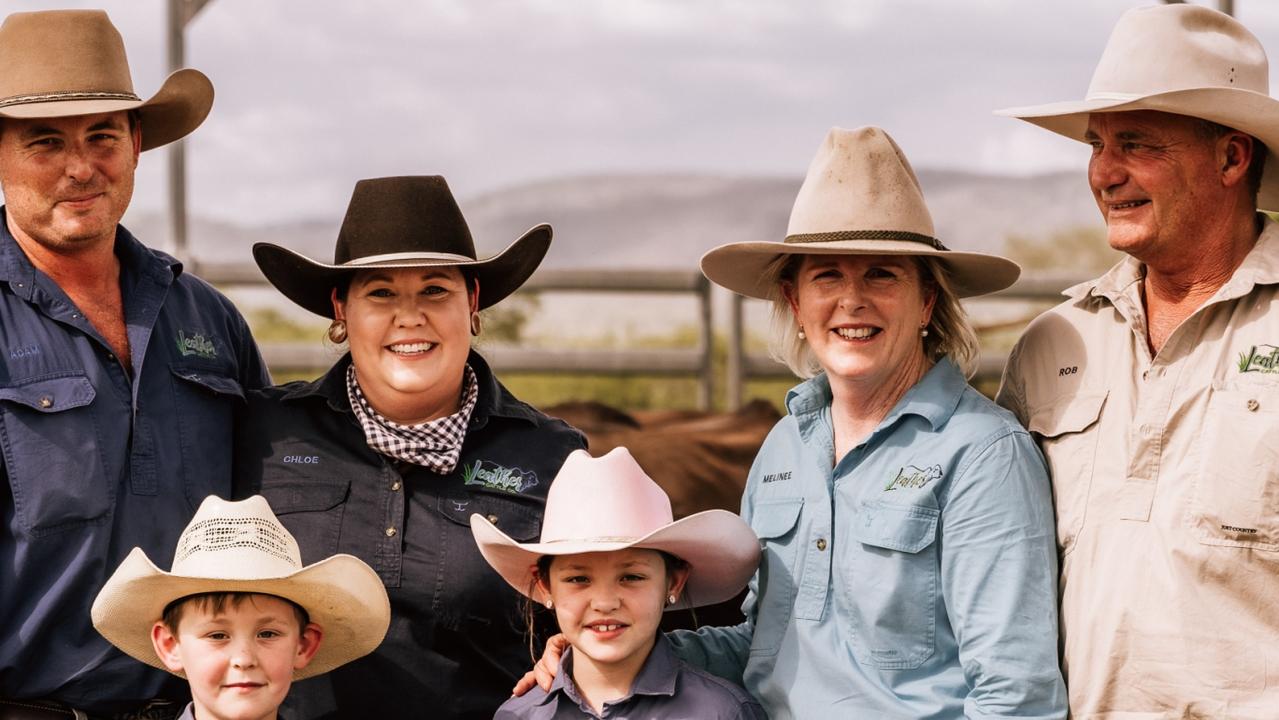Australian dairy industry: Gamble family’s Goulburn Valley success
Siblings Ashleigh and Chris Gamble are fourth generation dairy farmers, and their mix of strategy and calculated risk has paid off big time.
They may be Gamble by name, but when it comes to proper planning, this Goulburn Valley farming family doesn’t gamble by nature.
Siblings Ashleigh and Chris Gamble are the fourth generation to take on the challenge of operating a dairy farm at Bamawm, 20-minutes drive southwest of Echuca.
Along with parents Colin and Karen, the Gamble family runs a 375ha dairy farm with a feedpad at the core of the business.
The family operation has a herd of 480 cattle in total, with approximately 370-380 passing through their rapid exit model dairy at any given time.
Colin’s grandparents established the ancestral property, now known as Fair View Farms, only a few years prior to the outbreak of World War I in 1912.
“The farm was around 111 acres (45 hectares) for a long time,” Ashleigh said.
“Then Mum and Dad added 103 acres in 1995, another 112 acres in ’96. Then in 2015, we added 397 acres and 25 acres the following year in 2016.
“We own 750 acres (300ha) now all up, and also lease 175 acres (75ha).”

LAUNCH PAD
While operations remained the same on the Bamawm farm for a century, the fast-forward button has been pressed in recent times.
Colin and Karen used to run a perennial pasture-based system, milking about 300 cows, directly grazing rye-grass and lucerne-based pastures.
They would also feed out hay and silage in hay rings in the paddock.
Aside from homegrown fodder, they purchased about 320 tonnes of hay each season.
With a steep rise in water and feed prices eight years ago, the Gambles first leased a mixer wagon in November 2015.
They were impressed with the results and purchased their own mixer wagon in 2016.
But the 2016 calendar year proved to be throughly soggy and the return of Chris and Ashleigh to the farm provided a refreshed farming focus.
“The winter and the spring back in 2016 was really wet and we had a lot of feed wastage,” Ashleigh said.
“We were having issues getting the mixer wagon out to the paddock.
“With the paddocks so boggy, it meant a lot of the cows really struggled — our production figures dropped a huge amount. We could see there was a need to change things.”
They tapped into the Goulburn Murray Water Connections project to provide about 25 per cent of the earth with the remainder sourced by digging an effluent pond alongside the feed
pad for the flood-wash system.
“The olden day rule was ‘one cow to one acre’ but the feedlot changed the way we operate completely,” Ashleigh said.
“Our farm’s (soil composition) is about 25 per cent sandy loam, 50 per cent clay loam and about 25 per cent heavy clay.
“We don’t have any permanent pasture these days — we now have 150 acres (60ha) of maize that’s double cropped with vetch, about 100 acres (40ha) of lucerne, about 50 acres (20ha) annual, and the remainder is for cropping.”

DOLLARS AND SENSE
Constructing the feedpad didn’t come cheap — but the Gambles say the gamble paid off.
Earthworks to form the base cost about $10,000 but the family had their own earthmoving equipment, reducing costs by about $50,000 with savings on labour, fuel and maintenance.
The concrete and metal works equated to $220,000 while the water troughs, flood wash, pumps, pipes and related infrastructure tallied about $80,000.
In total, the cost of the feed pad was about $310,000.
Ashleigh said some within the dairy sector, and the community more broadly, were sceptical about the benefits of feedpads.
But the model was commonplace across continental Europe, and the 32-year-old farmer said a number of other primary producers had since been converted.
“There’s upsides and downsides with feedpads, but the upsides outweigh the downsides,” Ashleigh said.
“Production is way higher as a result. You can control what goes in and what goes out.”
And obviously, the cattle avoid the extremes of summer and winter compared to their equivalents on open pastures.
“You can tell the cows are way happier. The food is right there, water is right there, the bedding is right there and they get to lay down on this fluffy, soft area.”
So what are the downsides? Ashleigh said while the cattle were comfortable, the Gamble family and their employees couldn’t afford to rest on their laurels.
“It is so much more labour intensive than what you would think,” Ashleigh said.
“You’ve got to have someone rotary hoe it and cultivate it every day, twice a day.
“When Mum and Dad used to have (conventional grazing), you’d just send the cows through the gate, out into the paddock most of the time. Now there’s a minimum of four people here in the morning.”

FAMILY TIES
Three full-time and two part-time workers form the Fair View staff. But the family is core to the operations.
Along with 36-year-old brother Chris, parents Colin and Karen are still part of the Gamble farming operation but have gradually eased back to allow the next generation to have an increased say.
“Chris is more of the cropping side of the business and I’m more the cow side of the business,” Ashleigh said.
“Anything to do with the animals is my area. So we don’t cross over as much as some people would think from the outside.
“Some people are more animal-focused, some prefer the pasture side, so it’s a good balance to have.”
During the 2022-23 financial year, the Gamble family operation produced 4.4 million litres — with an average 750 kilograms of milk solids per cow.
The Bamawm district has an average of 400 millimetres per annum and the current season has been favourable.
What has been less certain of late is the labour market. The Gambles have been fortunate, with a dedicated small team.
But Ashleigh said across northern Victoria, many farmers were struggling to attract workers.
As a result, many generational dairy farmers are turning to the beef sector, dodging expansion or getting out of the milk market altogether.
“For somebody born on a dairy farm, I’d advise getting off the farm in your 20s and exploring other farms and seeing how other careers work before returning to the farm,” Ashleigh said.
“If you’re not born on a dairy farm, apply for a job. Be honest: say you’ve got no skills but you’re willing to learn.
“We’re always more than happy to take people who are upfront like that, they may not have that background but if they’re enthusiastic, willing to learn and motivated – they’re the three key words we’re looking for. We’d have you in a heartbeat.”





